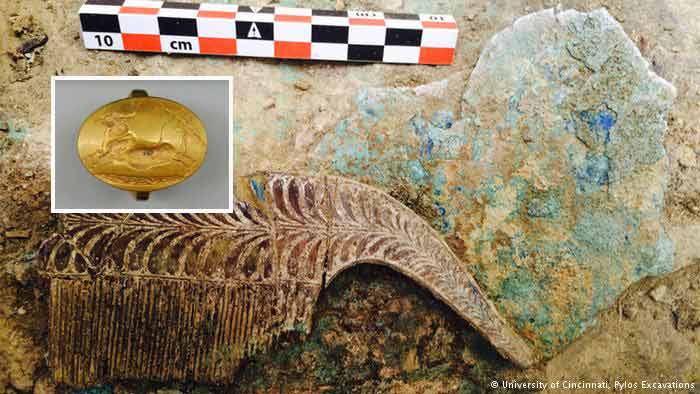
The Bronze Age tomb dates back to about 1500 BC and was discovered in Pylos, southern Peloponnese, by an international archaeological research team led by The University of Cincinnati. It belongs to a wealthy Mycenaean warrior and it is a great display of prehistoric wealth, according to the researchers.
An impressive treasure was buried with the warrior at the time of his death. The tomb has not been looted, and the fact that the vessels found in the tomb are of metal is an indicator of his great wealth, according to archaeologists.
Four complete solid-gold seal rings to be worn on a human finger, two squashed gold cups and a silver cup with a gold rim, a delicate necklace of square box-shaped golden wires, over 30 inches long with two gold pendants decorated with ivy leaves were found in the tomb. In addition, silver cups, bronze weapons, pieces of carved ivory and precious stone beads were also found
“It is truly amazing that no ceramic vessels were included among the grave gifts. All the cups, pitchers and basins we found were of metal: bronze, silver and gold. He clearly could afford to hold regular pots of ceramic in disdain,” said Shari Stocker, senior research associate in the Department of Classics, McMicken College of Arts and Sciences.
The site of the tomb is near the famed Palace of Nestor that was discovered in 1939. However, Stocker said, it is not related to King Nestor, the man who led a Greek armed force at Troy in Homer’s “Iliad“. Nor it is related to Nestor’s father, Neleus. The palace is also mentioned in “Odyssey“.
“This find may be even more important because the warrior pre-dates the time of Nestor and Neleus by, perhaps, 200 or 300 years. That means he was likely an important figure at a time when this part of Greece was being indelibly shaped by close contact with Crete, Europe’s first advanced civilisation,” Stocker said.
Archaeologists suggest the tomb may have held a powerful warrior or king, or even a rich trader, who died at about 30 to 35 years of age but who helped to lay the foundations of the Mycenaean culture that later flourished.
See all the latest news from Greece and the world at Greekreporter.com. Contact our newsroom to report an update or send your story, photos and videos. Follow GR on Google News and subscribe here to our daily email!



